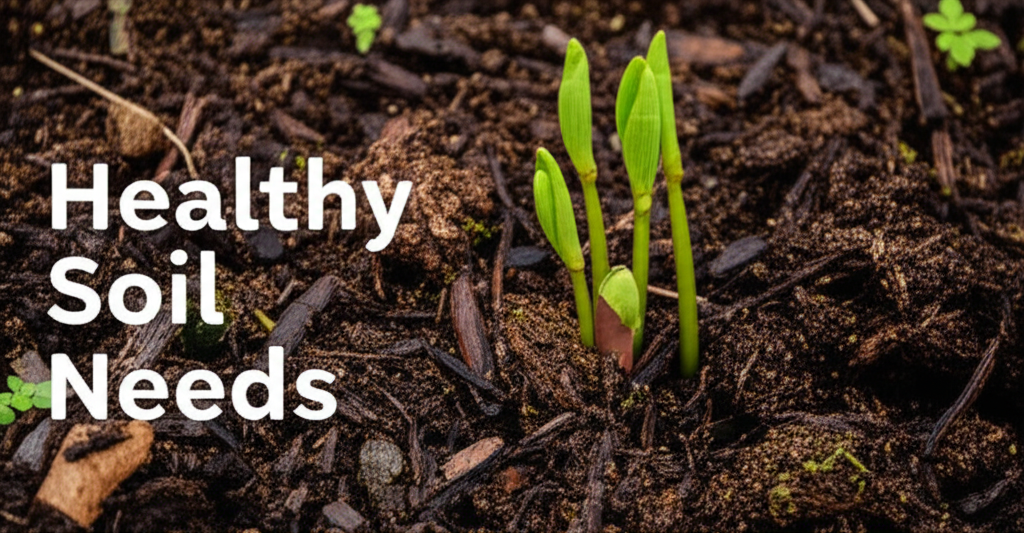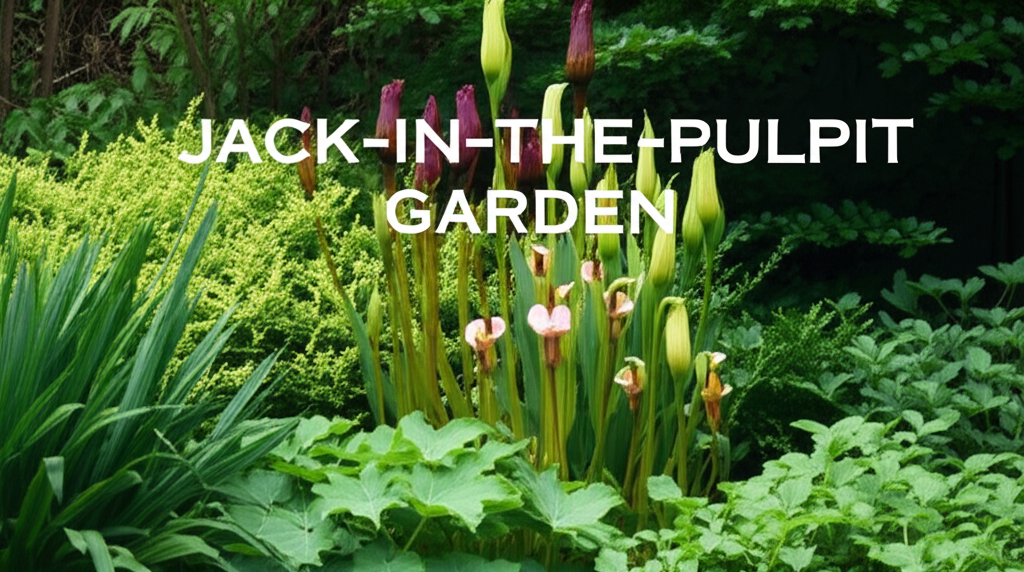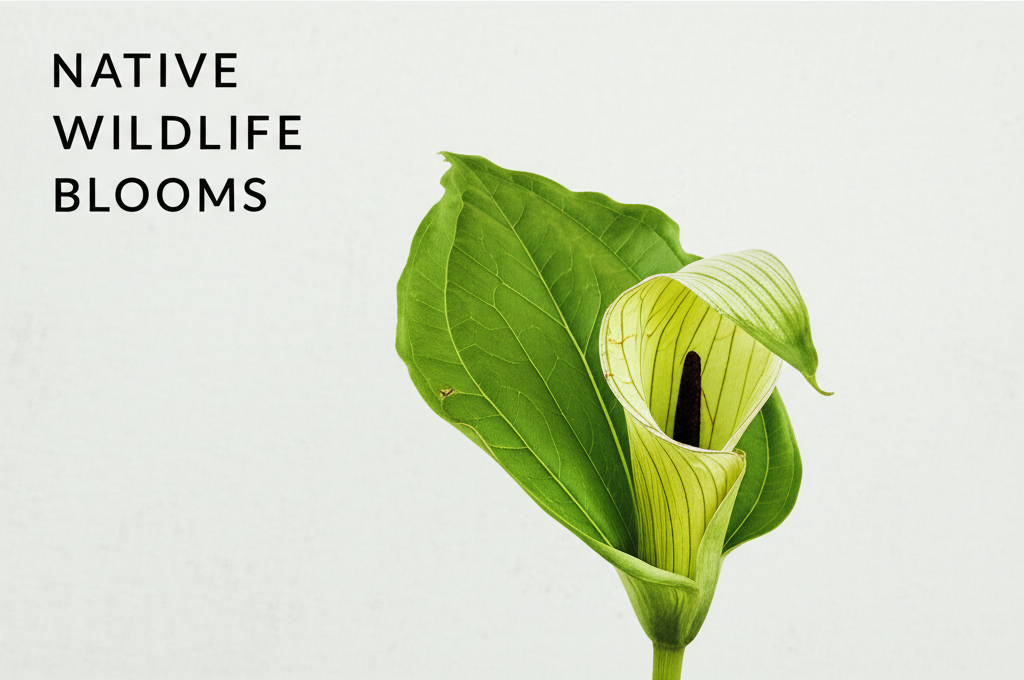The Foundation of Vitality: Understanding Jack-in-the-Pulpit’s Soil Needs
The enigmatic Jack-in-the-Pulpit (Arisaema triphyllum) is a woodland gem, instantly recognizable by its unique hooded spathe and spadix, resembling a preacher in a pulpit. To coax this captivating native perennial from its dormant state into a thriving specimen, understanding its specific soil requirements is paramount. This plant, a member of the Araceae family, is not a demanding diva, but it does possess particular preferences that, when met, will reward gardeners with its distinctive beauty and ecological benefits.
This article delves deep into the intricate world of soil for Jack-in-the-Pulpit, exploring everything from pH levels and moisture retention to organic matter and drainage. Whether you’re a seasoned woodland gardener or just beginning to explore native flora, this guide will equip you with the knowledge to create the perfect subterranean environment for your Arisaema triphyllum to flourish.
Decoding the Ideal Soil Mix: A Multi-Faceted Approach

Jack-in-the-Pulpit thrives in environments that mimic its natural habitat: the dappled shade of deciduous forests. This translates to specific soil characteristics that prioritize moisture, aeration, and nutrient richness.
pH Preference: The Sweet Spot for Arisaema
While Jack-in-the-Pulpit can tolerate a range of soil pH levels, it generally prefers slightly acidic to neutral conditions. An ideal pH falls between 6.0 and 7.0. Deviations outside this range can impact nutrient availability and the plant’s overall health.
- Slightly Acidic (pH 6.0-6.5): This is often considered the sweet spot. Many native woodland plants, including Jack-in-the-Pulpit, have evolved to thrive in soils that are naturally a bit acidic due to the decomposition of leaf litter from deciduous trees.
- Neutral (pH 6.5-7.0): The plant can also perform well in neutral soils.
- Slightly Alkaline (pH above 7.0): While it may survive, growth can be stunted, and the plant may exhibit signs of nutrient deficiency, such as yellowing leaves.
Testing your soil’s pH is a simple yet crucial step. Kits are readily available at garden centers or through local extension offices. If your soil is too alkaline, amendments like elemental sulfur or peat moss can be used to gradually lower the pH. Conversely, if the soil is too acidic, incorporating garden lime can help raise it. Always amend gradually and retest after a few months.
Moisture Retention: The Key to Hydration
Jack-in-the-Pulpit hails from woodland environments that typically experience consistent moisture, especially during its growing season. Therefore, soil that can retain moisture without becoming waterlogged is essential.
- Consistent but not Soggy: The ideal soil will hold enough water to keep the roots hydrated, preventing them from drying out.
- Avoid Waterlogging: However, prolonged saturation can lead to root rot, a fatal condition for many plants, including Jack-in-the-Pulpit. Excellent drainage is equally important to prevent this.
Organic Matter: The Engine of Fertility and Structure
The rich, dark soil found on forest floors is a testament to the power of organic matter. For Jack-in-the-Pulpit, a high content of decomposed organic material is a significant advantage.
- Nutrient Supply: Decomposing organic matter, such as leaf mold, compost, and aged manure, provides a slow and steady release of essential nutrients that the plant needs for robust growth and flowering.
- Improved Soil Structure: Organic matter helps to bind soil particles together, creating a crumbly texture that promotes aeration and drainage. It also enhances the soil’s ability to retain moisture.
- Beneficial Microbes: A healthy soil ecosystem teeming with beneficial microbes, often found in organically rich soils, further aids nutrient cycling and plant health.
Drainage: The Breathability Factor
While Jack-in-the-Pulpit enjoys consistent moisture, it absolutely detests “wet feet.” This means the soil must drain freely, allowing excess water to escape and preventing the corm from sitting in stagnant water.
- Sandy Loam: A sandy loam texture is often ideal, as it combines the water-retention properties of loam with the excellent drainage of sand.
- Preventing Root Rot: Proper drainage is the most critical factor in preventing root rot, which can quickly succumb the corms.
Key Soil Components for Jack-in-the-Pulpit
To create the perfect soil blend for your Jack-in-the-Pulpit, consider incorporating the following components:
1. Forest Floor Mix (Leaf Mold)
Leaf mold, created from the slow decomposition of fallen leaves, is arguably the single best amendment for Jack-in-the-Pulpit. It provides:
- Excellent moisture retention.
- A rich source of nutrients.
- A slightly acidic pH.
- A loose, crumbly texture that promotes aeration.
You can create your own leaf mold by piling leaves in a corner of your yard and letting them decompose for at least a year, or by purchasing it from reputable garden suppliers.
2. Well-Composted Compost
High-quality, well-rotted compost is another invaluable addition. It offers:
- A balanced supply of nutrients.
- Improved soil structure.
- Enhanced water-holding capacity.
- Introduction of beneficial microorganisms.
Ensure the compost is fully decomposed; unfinished compost can sometimes tie up nitrogen in the soil.
3. Coarse Sand or Perlite
To ensure adequate drainage, especially in heavier soils, incorporating coarse sand or perlite is highly recommended.
- Coarse Sand: Washed coarse sand (not play sand, which is too fine) helps to create air pockets within the soil, improving drainage and preventing compaction.
- Perlite: This lightweight volcanic rock also aids in aeration and drainage, and it doesn’t break down over time like some other amendments.
4. Peat Moss or Coconut Coir
These materials can be used to improve moisture retention and adjust soil pH.
- Peat Moss: A traditional choice, peat moss is excellent at holding moisture and can slightly acidify the soil. However, there are environmental concerns regarding its harvesting, so consider sustainable alternatives.
- Coconut Coir: A more sustainable alternative to peat moss, coconut coir also offers superb moisture retention and can help improve soil structure.
Creating the Ideal Soil Blend: Practical Applications
The best soil for Jack-in-the-Pulpit is a well-draining, humus-rich mixture. Here are a few practical approaches to achieving this:
1. For Existing Garden Beds
If you’re planting in an existing garden bed, amend the native soil generously:
- Excavate: Dig out the planting area to a depth of at least 8-10 inches.
- Amend: Mix in a generous amount of leaf mold, compost, and a handful of coarse sand or perlite into the excavated soil. A good starting ratio might be 50% existing soil, 30% leaf mold, 15% compost, and 5% sand/perlite.
- Backfill: Return the amended soil to the hole, ensuring it is loose and well-mixed.
2. For Container Growing
Growing Jack-in-the-Pulpit in containers requires a carefully formulated potting mix:
- Base: Use a high-quality potting mix as a base.
- Additions: Incorporate leaf mold, compost, and perlite or coarse sand at approximately a 1:1:1 ratio. This ensures excellent drainage, aeration, and moisture retention.
- Avoid Garden Soil: Do not use heavy garden soil in containers, as it can compact and hinder drainage.
Soil Comparison: Native vs. Amended Soil
To better illustrate the importance of soil preparation, consider this comparison:
| Feature | Native Woodland Soil (Ideal) | Typical Garden Soil (Unamended) | Amended Soil for Jack-in-the-Pulpit |
| :—————- | :————————————— | :—————————————- | :—————————————— |
| pH | Slightly acidic to neutral (6.0-7.0) | Varies greatly, often neutral to alkaline | Slightly acidic to neutral (6.0-7.0) |
| Organic Matter| High (leaf litter, decomposed matter) | Moderate to low | High (leaf mold, compost) |
| Drainage | Excellent (forest floor allows runoff) | Can be poor (compacted, clayey) | Excellent (improved with sand/perlite) |
| Moisture | Consistently moist, not waterlogged | Can be dry or waterlogged | Consistently moist, not waterlogged |
| Texture | Loose, crumbly, well-aerated | Can be heavy, compacted, or sandy | Loose, crumbly, well-aerated |
| Nutrient Level| Rich and balanced | Varies, can be depleted | Rich and balanced |
This table highlights how amending your soil provides a more controlled and favorable environment for Jack-in-the-Pulpit, even if your native soil isn’t naturally ideal.
Step-by-Step Soil Preparation and Planting
Follow these steps to ensure your Jack-in-the-Pulpit has the best start:
Step-by-Step Guide
- Select a Planting Location: Choose a spot that receives dappled shade or morning sun and afternoon shade.
- Test Soil pH: Determine the existing pH of your planting area.
- Amend the Soil: If necessary, adjust the pH to the target range of 6.0-7.0 using appropriate amendments.
- Incorporate Organic Matter: Generously mix in leaf mold, well-rotted compost, and a soil conditioner like coarse sand or perlite to improve drainage and aeration. Aim for a rich, well-draining mixture.
- Dig the Planting Hole: Dig a hole that is twice as wide and as deep as the plant’s root ball or corm.
- Plant the Corm: Place the corm in the hole with the pointed end (or any side if it’s not clearly defined) facing upwards. Plant it about 2-3 inches deep.
- Backfill and Water: Gently backfill the hole with the amended soil, ensuring there are no air pockets. Water thoroughly to settle the soil.
- Mulch: Apply a layer of organic mulch (such as shredded leaves or wood chips) around the base of the plant, keeping it a few inches away from the stem. This helps retain moisture, suppress weeds, and regulate soil temperature.
Pros and Cons of Different Soil Approaches
Understanding the advantages and disadvantages of various soil amendments can help you make informed decisions:
| Soil Amendment | Pros | Cons |
| :—————— | :————————————————————————————– | :—————————————————————————————— |
| Leaf Mold | Excellent moisture retention, nutrient-rich, slightly acidic, improves structure | Can be difficult to source in large quantities, takes time to create naturally |
| Compost | Nutrient-rich, improves structure, enhances moisture retention, beneficial microbes | Must be well-rotted, can sometimes be too dense if not mixed with other materials |
| Coarse Sand | Improves drainage and aeration, prevents compaction | Too much can lead to excessive dryness, not all sand is suitable (avoid fine play sand) |
| Perlite | Improves drainage and aeration, lightweight | Can float to the surface over time, does not add nutrients |
| Peat Moss | Excellent moisture retention, slightly acidic | Environmental concerns regarding harvesting, can become hydrophobic if allowed to dry out |
| Coconut Coir | Excellent moisture retention, sustainable alternative to peat, improves structure | Can sometimes be too fine, may require buffering if not pH balanced |
By carefully balancing these components, you can create a soil environment that truly caters to the specific needs of your Jack-in-the-Pulpit.
Seasonal Soil Considerations and Maintenance
While the initial soil preparation is crucial, ongoing soil management ensures long-term health and vitality for your Jack-in-the-Pulpit.
Fall and Winter
As the plant dies back in the fall, the leaves will blacken and collapse. This is the ideal time to replenish the soil.
- Mulching: Add a fresh layer of leaf mold or compost around the base of the plant. This not only feeds the soil as it decomposes but also insulates the dormant corm from extreme temperature fluctuations and helps retain moisture.
- Leaf Litter: Allowing a natural layer of fallen leaves to accumulate around the plant in woodland settings is a highly beneficial practice, mimicking its natural environment.
Spring
In early spring, as new growth begins to emerge, you can lightly top-dress the soil with more compost.
- Weed Control: Keep the area around your Jack-in-the-Pulpit free of weeds, which compete for moisture and nutrients. Be careful not to disturb the shallow roots when weeding.
- Moisture Monitoring: Ensure the soil remains consistently moist, especially during dry spells, but avoid overwatering.
Summer
During the summer, the plant will typically complete its flowering and seed production, and may even go dormant in drier conditions.
- Watering: Water deeply if the soil becomes dry, but allow it to drain well.
- Avoid Disturbing: Try not to disturb the soil excessively once the plant is established.
Conclusion: Cultivating a Thriving Woodland Specimen
Jack-in-the-Pulpit, with its captivating form and ecological significance, is a rewarding plant to cultivate. By understanding and meticulously addressing its soil requirements – namely a slightly acidic to neutral pH, consistent moisture retention, ample organic matter, and excellent drainage – you provide the fundamental building blocks for its success.
From the rich humus of leaf mold to the aeration provided by coarse sand, each component plays a vital role in creating a subterranean haven. Whether you’re amending existing beds or crafting a bespoke potting mix, the principles remain the same: mimic the healthy, life-giving environment of a flourishing forest floor. With a little attention to detail and a commitment to providing the right soil, your Jack-in-the-Pulpit will undoubtedly reward you with its unique beauty and presence for years to come.
html
<h2>Soil Requirements for Healthy Jack-in-the-Pulpit Growth: Key Facts/Comparison</h2>
<table>
<thead>
<tr>
<th>Soil Characteristic</th>
<th>Ideal for Jack-in-the-Pulpit</th>
<th>Why it Matters</th>
<th>Alternatives/Considerations</th>
</tr>
</thead>
<tbody>
<tr>
<td>Soil Type</td>
<td>Rich, humus-rich, well-draining soil</td>
<td>Provides essential nutrients and prevents root rot</td>
<td>Can tolerate loam and sandy loam if amended</td>
</tr>
<tr>
<td>pH Level</td>
<td>Slightly acidic to neutral (5.5 - 7.0)</td>
<td>Optimal for nutrient uptake</td>
<td>Avoid highly alkaline soils</td>
</tr>
<tr>
<td>Moisture Retention</td>
<td>Consistently moist, but not waterlogged</td>
<td>Mimics its native woodland habitat; prevents drying out</td>
<td>Mulching helps retain moisture; avoid overwatering</td>
</tr>
<tr>
<td>Organic Matter</td>
<td>High content of decomposed leaves, compost, or aged manure</td>
<td>Supplies slow-release nutrients and improves soil structure</td>
<td>Incorporate annually to maintain fertility</td>
</tr>
<tr>
<td>Drainage</td>
<td>Excellent drainage is crucial</td>
<td>Prevents fungal diseases and corm rot</td>
<td>Amend heavy clay soils with compost or sand</td>
</tr>
</tbody>
</table>
<h2>Soil Requirements for Healthy Jack-in-the-Pulpit Growth: Steps/Pros-Cons</h2>
<table>
<thead>
<tr>
<th>Action/Consideration</th>
<th>Pros</th>
<th>Cons</th>
</tr>
</thead>
<tbody>
<tr>
<td><strong>Amending Soil with Compost</strong></td>
<td>Improves soil structure, fertility, and moisture retention. Mimics natural woodland conditions.</td>
<td>Requires sourcing or making compost. Can initially attract pests if not well-rotted.</td>
</tr>
<tr>
<td><strong>Ensuring Good Drainage</strong></td>
<td>Prevents root rot and fungal diseases, crucial for corm health.</td>
<td>May require amendments for heavy clay soils. Can lead to drying out if excessive.</td>
</tr>
<tr>
<td><strong>Maintaining Consistent Moisture</strong></td>
<td>Supports healthy leaf and flower development during the growing season.</td>
<td>Overwatering can lead to corm rot. Requires regular monitoring, especially in dry periods.</td>
</tr>
<tr>
<td><strong>Selecting a Shady Location</strong></td>
<td>Jack-in-the-Pulpit thrives in dappled shade, replicating its native woodland environment.</td>
<td>Too much shade can reduce vigor and flowering. Requires careful placement to avoid deep shade.</td>
</tr>
<tr>
<td><strong>Testing Soil pH</strong></td>
<td>Ensures optimal nutrient availability for the plant.</td>
<td>Requires a soil testing kit. Adjustments may be needed to correct pH.</td>
</tr>
</tbody>
</table>


